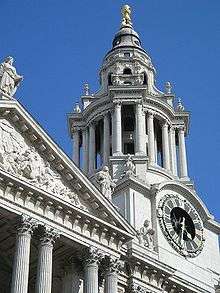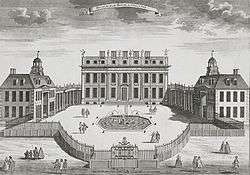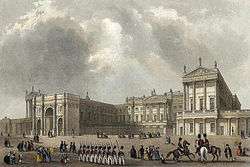18th-century London
Part of a series on the |
|---|
| History of London |
| See also |
|
|
The 18th century was a period of rapid growth for London, reflecting an increasing national population, the early stirrings of the Industrial Revolution, and London's role at the centre of the evolving British Empire.
London cityscape in the 18th century
In 1707, an Act of Union was passed merging the Parliament of Scotland and the Parliament of England, thus establishing The Kingdom of Great Britain. A year later, in 1708 Christopher Wren's masterpiece, St. Paul's Cathedral was completed on his birthday. The first service had been held on December 2, 1697, more than 10 years earlier. This Cathedral replaced the original St. Paul's which had been completely destroyed in the Great Fire of London. This building is considered one of the finest in Britain and a fine example of Baroque architecture.

Georgian Era (1714–1837)
During the Georgian era, London spread beyond its traditional limits at an accelerating pace. New districts such as Mayfair were built for the rich in the West End. New bridges over the Thames encouraged an acceleration of development in South London. In the East End, the Port of London expanded downstream from the City.
During this period was also the uprising of the American colonies. In 1780, the Tower of London held its only American prisoner, former President of the Continental Congress, Henry Laurens. In 1779, he was the Congress's representative of Holland, and got the country's support for the Revolution. On his return voyage back to America, the Royal Navy captured him and charged him with treason after finding evidence of a reason of war between Great Britain and the Netherlands. He was released from the Tower on December 21, 1781, in exchange for General Lord Cornwallis.
In 1762, George III acquired Buckingham Palace (then known as "house") from the Duke of Buckingham. It was enlarged over the next 75 years by architects such as John Nash. It would not be until the 19th century that the palace would become the principal London royal residence.


18th century social history
A phenomenon of 18th-century London was the coffee house, which became a popular place to debate ideas. Growing literacy and the development of the printing press meant that news became widely available. Fleet Street became the centre of the embryonic British press during the century.
Up until 1750, London Bridge was the only crossing over the Thames, but in that year Westminster Bridge was opened.
The Bow Street Runners were established in 1749 as a professional police force. Penalties for crime were harsh, with the death penalty being applied for fairly minor crimes. Public hangings were common in London, and were popular public events.
In 1780, London was rocked by the Gordon Riots, an uprising by Protestants against Roman Catholic emancipation led by Lord George Gordon. Severe damage was caused to Catholic churches and homes, and 285 rioters were killed.
See also
Further reading
Published in the 18th century
- Daniel Defoe; Samuel Richardson (1778), "London", A Tour Through the Island of Great Britain (8th ed.), London: J.F. and C. Rivington
- W. Bailey (1781). "London Directory". Bailey's Northern Directory. Warrington: Printed by William Ashton.
- John Trusler (1790), London Adviser and Guide (2nd ed.), Printed for the author at the Literary-Press, OCLC 15076772
- Thomas Pennant (1790), Of London, London: Printed for Robt. Faulder, OCLC 5452113 + index
- Daniel Lysons (1792), Environs of London, 1: County of Surrey, London: T. Cadell . + v.2, v.3 (Middlesex); v.4 (Herts, Essex & Kent)
- Archibald Robertson (1792), "London", Topographical Survey of the Great Road from London to Bath and Bristol, London, OCLC 1633468
Published in the 20th century
- Walter Besant (1902), London in the Eighteenth Century, Survey of London, London: A. & C. Black
- Miles Ogborn (1998). Spaces of Modernity: London's Geographies, 1680-1780. Guilford Press. ISBN 978-1-57230-365-2.
External links
| Wikimedia Commons has media related to London in the 18th century. |
- London Lives - A database hosting digital copies of Archival materials from 18th century London